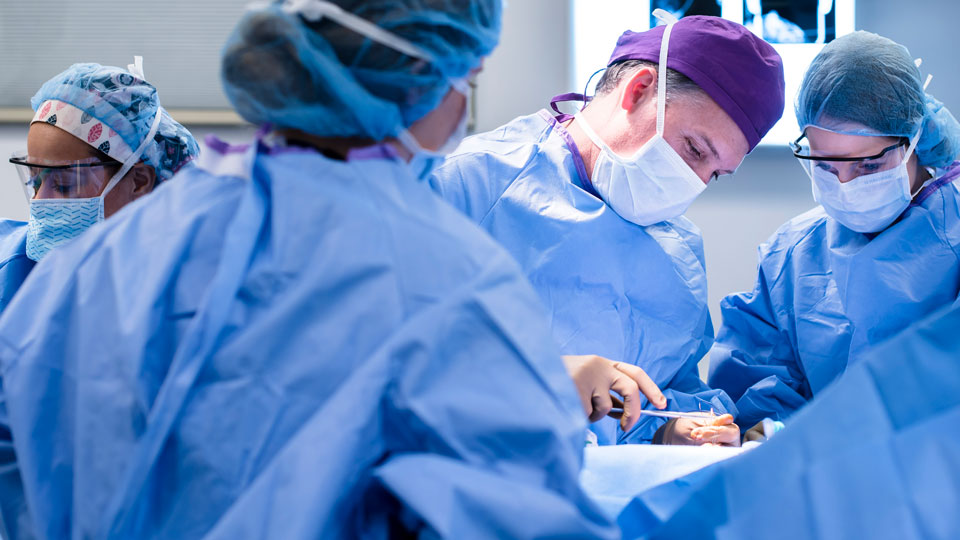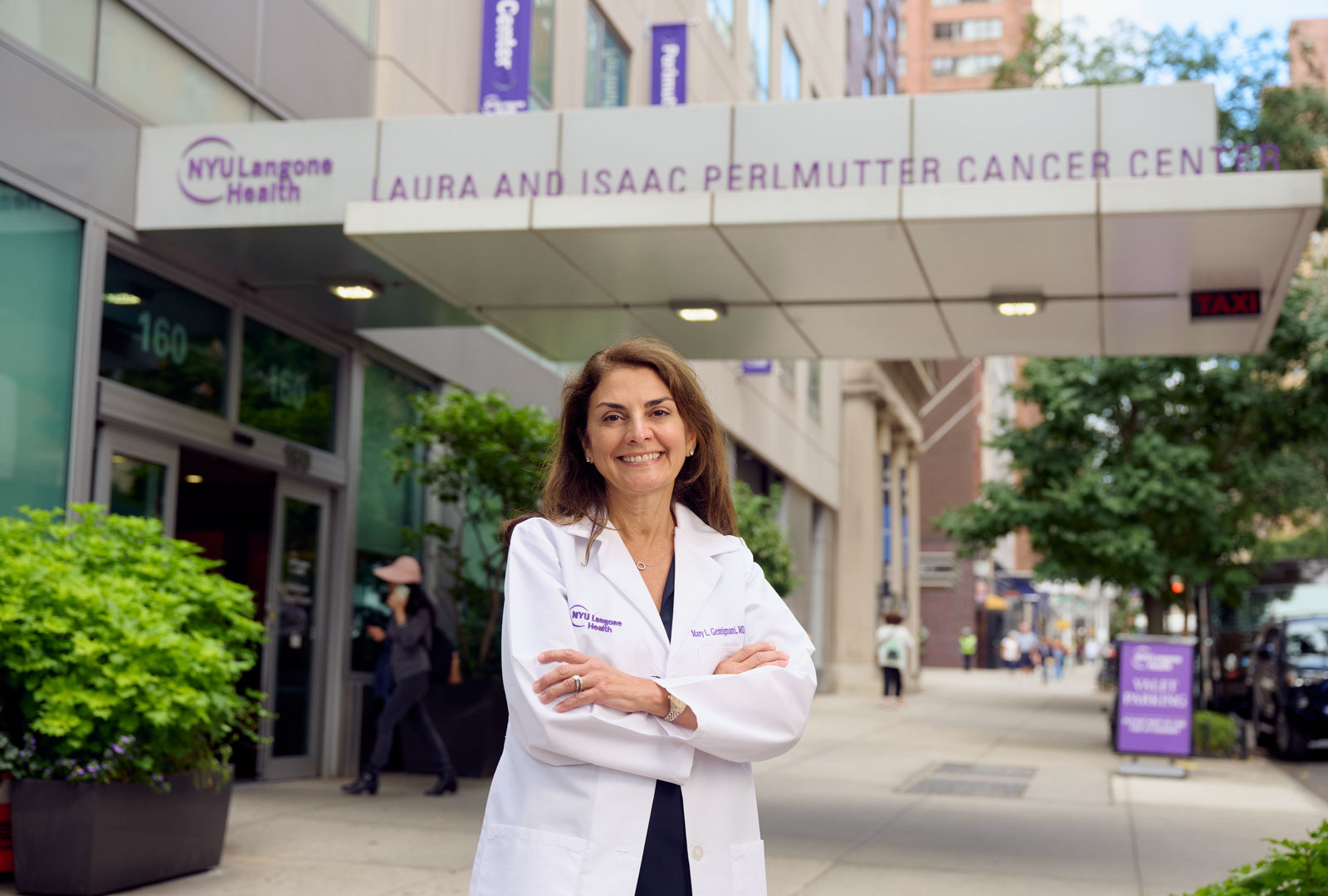Surgery for Breast Cancer
Most patients with breast cancer need surgery, either a breast-conserving procedure or a mastectomy, as part of their treatment. The decision of which type of surgery is best depends on many factors, including the extent of breast cancer, family medical history, genetic risks, and your personal preferences.
Our surgeons are highly skilled in breast cancer surgery, committed to compassionate care, and work closely with you to determine which surgery is the right one for you.
Our doctors also specialize in preventive surgery.
Breast-Conserving Surgery
Breast-conserving surgery, also called a lumpectomy or partial mastectomy, is an option for women with ductal carcinoma in situ (DCIS) and invasive breast cancer.
This surgery is typically followed by radiation therapy (X-ray or other energy) to lower the risk of the cancer returning. Your surgeon may recommend that you see a radiation oncologist, a doctor who specializes in the use of radiation therapy, to discuss the need for radiation after breast-conserving surgery.
During breast-conserving surgery, our surgeons remove the cancer along with a border of healthy breast tissue called a surgical margin. Our surgeons plan treatment with the goal of leaving as much of the breast intact as possible. This surgery is usually an outpatient procedure, so you do not have to stay overnight in the hospital.

Our surgeons use state-of-the-art localization, with non-radioactive techniques such as SAVI SCOUT or Magseed, which precisely locate and assist in removing small breast cancers that are detected on imaging studies but not felt on breast exams. This localization procedure can be performed well in advance of surgery and scheduled at a time that is convenient for you, making the day of surgery shorter and less stressful.
Tissue Analysis and Further Surgery
Pathologists evaluate the tumor and tissue margins, and test results are available after the surgery is complete. Some patients may need additional surgery called a re-excision lumpectomy if the pathology from the surgery reveals that cancer cells are present at the margin, known as a positive margin. New guidelines have defined what a positive margin is and have reduced the need for additional surgery.

Our surgeons follow these guidelines and are adept at using several techniques that reduce the need for re-excision. One example is Margin Probe, which is an intraoperative device that uses electromagnetic waves to examine the surface of the tumor after it is removed and a console that analyzes the probe’s measurements. This information helps surgeons determine if the tissue margin contains cancer cells. If cancer cells are present, more surgery may be needed.
Oncoplastic Surgery
Oncoplastic surgery removes the tumor using aesthetic techniques to achieve the best cosmetic results. This approach maintains breast symmetry and a more natural appearance after a lumpectomy.
Our surgeons are experienced in oncoplastic surgery techniques and may also work in tandem with our reconstructive plastic surgeons. Oncoplastic surgery options are varied, and depend on the breast cancer characteristics, your individual body and desired outcomes. You may discuss whether you are a candidate for oncoplastic surgery options with your breast surgeon and or plastic surgeon.
Our surgeons can also perform a lumpectomy or mastectomy using the Hidden Scar procedure. This surgical technique removes cancerous tissue from a single incision and hides visible scarring as much as possible.
Mastectomy
Mastectomy involves removing the entire breast, nipple, and areola, the ring of pigmented skin surrounding the nipple. This procedure may be recommended for women who have extensive DCIS and those who have a large invasive cancer or multiple tumors.
Surgeons may recommend a mastectomy when breast-conserving surgery might produce results that a woman finds cosmetically unacceptable. It may also be recommended if a woman has a breast cancer recurrence after being treated with breast-conserving surgery and radiation therapy.
Most mastectomies can be done using skin-sparing techniques, meaning surgeons remove breast tissue but leave behind as much healthy skin as possible for women who choose to have breast reconstruction. Your breast surgeon and reconstructive surgeon can discuss this option with you.
Your surgeon may also recommend that you see a radiation oncologist to discuss the need for radiation therapy after mastectomy.

Bilateral Mastectomy
A bilateral mastectomy involves removing both breasts and depends on the risk of cancer affecting the other breast in the future. Our surgeons can discuss whether this is the right option for you.
Several approaches to reconstruction are available at the time of the surgery, and our breast and reconstructive surgeons can discuss these with you.
Nipple-Sparing Mastectomy
For some women with very small tumors or early breast cancer that is not near the nipple or areola, surgeons can perform a nipple-sparing mastectomy that leaves the nipple and areola intact.
Doctors remove breast tissue as close to the nipple and areola as possible to ensure that all potentially cancerous cells are removed. Breast reconstruction is then performed at the same time as the mastectomy.
Several options for reconstruction are available at the time of the surgery to help a woman preserve the natural appearance of her breasts, including our breast in a day surgery, during which surgeons perform a nipple-sparing mastectomy and implant reconstruction on the same day.
A tiny amount of breast tissue is left behind during nipple-sparing mastectomy. For this reason, your doctors need to continually monitor you in the following years and can create a follow-up plan that is appropriate for you.
Sentinel Lymph Node Removal
Surgeons frequently perform a sentinel lymph node removal during breast-conserving surgery or mastectomy for invasive breast cancer. Lymph nodes are part of the lymphatic system, which consists of organs and vessels that drain excess fluid from tissues and help the body fight infections.
Before surgery, doctors inject a radioactive tracer. The tracer travels through the breast tissue to nearby lymph nodes under the arm. The first several nodes to absorb the tracer are called the sentinel nodes because if cancer spreads outside the breast, it is likely to spread to these nodes first.
Surgeons can find this node or nodes using a gamma probe, a device that can detect the radioactive tracer. A blue dye may be injected during surgery to further helps doctors identify the correct node or nodes to remove.
In breast-conserving surgery, surgeons remove the sentinel nodes through a small incision under the arm. The pathologist evaluates the sentinel nodes for cancer, and if they are negative, there is no need to remove additional lymph nodes. During mastectomy, surgeons may remove the sentinel nodes through the mastectomy incision or through a separate small incision under the arm.
If cancer is found in the sentinel nodes, your surgeon may discuss with you whether another procedure, called axillary lymph node dissection, is needed to remove additional nodes where cancer may have spread. New medical studies have shown that in many instances there is no need to remove additional lymph nodes if your sentinel nodes contain cancer. Your surgeon can discuss whether an axillary lymph node dissection is needed in your case.
Surgeons may also use a special nonradioactive tracer (Magtracer) that can be injected at the time of initial surgery and defer the sentinel node biopsy to a later time until after complete pathology is available. This reduces the need for sentinel node biopsy in many cases of mastectomy for DCIS where sentinel node involvement is not expected.
Axillary Lymph Node Dissection
An axillary lymph node dissection is usually required when cancer has spread to multiple lymph nodes. During an axillary lymph node dissection, surgeons may remove as many as 10 to 15 lymph nodes to evaluate how far the cancer has spread. This procedure is slightly more likely than sentinel lymph node removal to cause a condition called lymphedema, a swelling under the arm due to poor lymph fluid drainage. Our doctors can help you take steps to prevent lymphedema and manage it, if it occurs.
Recovery from Breast Surgery
If you’ve had breast-conserving surgery, you may go home the same day. If you’ve had a mastectomy, you may only have to spend one day in the hospital. However, if you’ve had reconstructive surgery, the stay is slightly longer and depends on the type of procedure. During this time, doctors monitor you and help manage any pain.
Patients who have axillary lymph node dissection or mastectomy return home with a drain placed under the arm. This tube drains fluid away from the wound and may need to stay in place for several days to help reduce swelling. Our nurses will instruct you on how to care for the drain and when to return to the office to remove it. This is usually at the time of the postoperative visit with your surgeon or reconstructive surgeon.
Our doctors and physical therapists at Rusk Rehabilitation can help you if you are at risk of developing or have lymphedema. At Perlmutter Cancer Center we offer an array of support services to help you recover from surgery and other treatments.
Meet Our Doctors
Perlmutter Cancer Center specialists provide care and support during treatment.
Browse Doctors